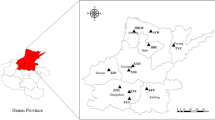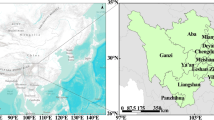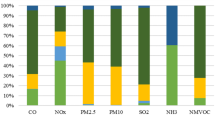Abstract
In this work, atmospheric pollutant emissions of NOx, SOx, CO, particulate matter (PM), total organic compounds (TOC), and CO2 from larger stationary sources of pollutants in Brazil were inventoried and spatialized over the whole Brazilian territory for the base year 2011. The developed inventory comprises a total of 16 refining units, 1730 thermoelectric power plants (TPPs), 96 cement industries, and 64 paper and cellulose industries. To obtain the dataset, some strategies were used, including mail contact, official datasets, personal requesting, web maps usage, and official industry websites. The emission factors were based on lower and upper limits proposed by the AP-42 standards of the US Environmental Protection Agency – USEPA, as well as, emission factors provided by air pollution control agencies, industries, and those identified in the scientific literature. The results show values of 857 ± 415 Gg/year for NOx, 1.51 ± 1.23 Tg/year for SOx, 21.2 ± 13.7 Tg/year for CO, 10.4 ± 10.1 Tg/year for PM, 1.14 ± 0.95 Tg/year for TOC, and 476 ± 142 Tg/year for CO2. In comparison with the official vehicular emission inventory provided by the Ministry of Environment for the year 2011, the total NOx emissions estimated in this work were slightly lower than vehicular emissions, while SOx was 300 times greater than vehicular emissions. For CO, the stationary emissions inventoried were around 17 times greater than vehicular emissions, while PM was approximately 360 times greater than those from vehicles. In terms of comparison with existing global databases, the estimates of this work showed a good level of agreement with the pollutants estimated by the Global Emissions EDGAR v4.3.1, except for PM and CO, which were higher in our estimates. The major contribution of the proposed inventory lies in its improved spatialized distribution, higher resolution, and greater distinctness about the high level of uncertainty associated with the emission inventories for the region.





Similar content being viewed by others
References
Abdallah C, Sartelet K, Afif C (2016) Influence of boundary conditions and anthropogenic emission inventories on simulated O3 and PM2.5 concentrations over Lebanon. Atmos Pollut Res:1–9. https://doi.org/10.1016/j.apr.2016.06.001
Abou Rafee SA, Martins LD, Kawashima AB, Almeida DS, Morais MV, Souza RV et al (2017) Contributions of mobile, stationary and biogenic sources to air pollution in the Amazon rainforest: a numerical study with the WRF-Chem model. Atmos Chem Phys 17(12):7977–7995. https://doi.org/10.5194/acp-17-7977-2017
Alonso MF, Longo KM, Freitas SR, da Fonseca RM, Marécal V, Pirre M, Klenner LG (2010) An urban emissions inventory for South America and its application in numerical modeling of atmospheric chemical composition at local and regional scales. Atmos Environ 44(39):5072–5083. https://doi.org/10.1016/j.atmosenv.2010.09.013
Aman S, Simmhan Y, Prasanna VK (2013) Energy management systems: state of the art and emerging trends. IEEE Commun Mag 51(1):114–119. https://doi.org/10.1109/MCOM.2013.6400447
Andrade MF, Ynoue RY, Freitas ED, Todesco E, Vara Vela A, Ibarra S et al (2015) Air quality forecasting system for Southeastern Brazil. Front Environ Sci 3:9. https://doi.org/10.3389/fenvs.2015.00009
Andrade MF, Kumar P, de Freitas ED, Ynoue RY, Martins J, Martins LD et al (2017) Air quality in the megacity of São Paulo: evolution over the last 30 years and future perspectives. Atmos Environ 159:66–82. https://doi.org/10.3389/fenvs.2015.00009
Bonan GB, Doney SC (2018) Climate, ecosystems, and planetary futures: the challenge to predict life in earth system models. Science 359(6375). https://doi.org/10.1126/science.aam8328
BRACELPA. Associação Brasileira de Celulose e papel. Relatório Estatístico 2013/2014. 2014. Disponível em: . Acesso em: 27 nov. 2014.
Carvalho VSB, Freitas ED, Martins LD, Martins JA, Mazzoli CR, de Fátima AM (2015) Air quality status and trends over the metropolitan area of São Paulo, Brazil as a result of emission control policies. Environ Sci Pol 47:68–79. https://doi.org/10.1016/j.envsci.2014.11.001
CETESB, Qualidade do ar no estado de São Paulo (2015) Companhia Ambiental do Estado de São Paulo (São Paulo State Environmental Protection Agency). http://ar.cetesb.sp.gov.br/publicacoes-relatorios/ (accessed jun 20, 2015)
Chen J, Li C, Ristovski Z, Milic A, Gu Y, Islam MS et al (2017) A review of biomass burning: emissions and impacts on air quality, health and climate in China. Sci Total Environ 579:1000–1034. https://doi.org/10.1016/j.scitotenv.2016.11.025
Crippa M, Guizzardi D, Muntean M, Schaaf E, Dentener F, van Aardenne JA et al (2018) Gridded emissions of air pollutants for the period 1970–2012 within EDGAR v4. 3.2. Earth Syst Sci Data 10(4):1987–2013. https://doi.org/10.5194/essd-10-1987-2018
D’Avignon A, Carloni FA, La Rovere EL, Dubeux CBS (2010) Emission inventory: an urban public policy instrument and benchmark. Energy Policy 38(9):4838–4847. https://doi.org/10.1016/j.enpol.2009.10.002
de Almeida Albuquerque TT, de Fátima Andrade M, Ynoue RY, Moreira DM, Andreão WL, Dos Santos FS et al (2018) WRF-SMOKE-CMAQ modeling system for air quality evaluation in São Paulo megacity with a 2008 experimental campaign data. Environ Sci Pollut Res Int 25(36):36555–36569
Diamond ML, de Wit CA, Molander S, Scheringer M, Backhaus T, Lohmann R et al (2015) Exploring the planetary boundary for chemical pollution. Environ Int 78:8–15. https://doi.org/10.1016/j.envint.2015.02.001
EPA, US (1995) AP 42, Compilation of air pollutant emission factors. Stationary point and area sources, 1.
EPE (2009) Empresa de Pesquisa Energética. Relatório Final do Balanço Energético Nacional (Brasil): Ano base 2009. Rio de Janeiro: 276p. Disponível em: . Acesso em: 20 de novembro de 2014.
Frost GJ, Middleton P, Tarraso’n L, Claire G, Guenther A, Cardenas B, van der Denier GH, Janssens-Maenhout G, Kaiser JW, Keating T, Klimont Z, Lamarque J-F, Liousse C, Nickovic S, Ohara T, Schultz MG, Skiba U, van Aardenne J, Wang Y (2013) New Directions: GEIA’s 2020 vision for better air emissions information. Atmos Environ. 81:710–712
Janssens-Maenhout G, Crippa M, Guizzardi D, Muntean M, Schaaf E, Dentener F et al (2019) EDGAR v4. 3.2 Global Atlas of the three major greenhouse gas emissions for the period 1970–2012. Earth System Science Data 11(3):959–1002. https://doi.org/10.5194/essd-11-959-2019
Gallagher J, Baldauf R, Fuller CH, Kumar P, Gill LW, McNabola A (2015) Passive methods for improving air quality in the built environment: a review of porous and solid barriers. Atmos Environ 120:61–70. https://doi.org/10.1016/j.atmosenv.2015.08.075
Gheorghe I F, Ion B (2011) The effects of air pollutants on vegetation and the role of vegetation in reducing atmospheric pollution. In The impact of air pollution on health, economy, environment and agricultural sources. IntechOpen. https://doi.org/10.5772/17660
Goldemberg J, & Lucon O (2008). Energia, meio ambiente e desenvolvimento. Edusp.
Gurjar BR, Ohara T, Khare M, Kulshrestha P, Tyagi V, Nagpure AS (2018) South Asian perspective: a case of urban air pollution and potential for climate co-benefits in India, In Mainstreaming Climate Co-Benefits in Indian Cities(pp. 77–98). Springer, Singapore. https://doi.org/10.1007/978-981-10-5816-5_3
Ibarra-Espinosa S, Ynoue R, O’Sullivan S, Pebesma E, Andrade MDF, Osses M (2018) VEIN v0. 2.2: an R package for bottom–up vehicular emissions inventories. Geosci Model Dev 11(6):2209–2229. https://doi.org/10.5194/gmd-11-2209-2018
IBGE (2014) Instituto Brasileiro de Geografia e Estatística. Distribuição da população por sexo. https://www.ibge.gov.br/.html. (Jan 10, 2015)
IPCC (2014) Climate Change 2014: synthesis report. Contribution of working groups I. Cambridge University Press, Cambridge, II and III to the fifth assessment report of the Intergovernmental Panel on Climate Change
Kawashima AB, de Morais MVB, Martins LD, Urbina V, Rafee SAA, Capucim MN, Martins JA (2015) Estimates and spatial distribution of emissions from sugar cane bagasse fired thermal power plants in Brazil. Journal of Geoscience and Environment Protection 3(06):72. https://doi.org/10.4236/gep.2015.36012
Kay JE, Deser C, Phillips A, Mai A, Hannay C, Strand G, Holland M (2015) The Community Earth System Model (CESM) large ensemble project: a community resource for studying climate change in the presence of internal climate variability. Bull Am Meteorol Soc 96(8):1333–1349. https://doi.org/10.1175/BAMS-D-13-00255.1
Kurokawa J, Ohara T, Morikawa T, Hanayama S, Janssens-Maenhout G, Fukui T et al (2013) Emissions of air pollutants and greenhouse gases over Asian regions during 2000–2008: regional emission inventory in ASia (REAS) version 2. Atmos Chem Phys 13(21):11,019–11,058. https://doi.org/10.5194/acp-13-11019-2013
Landrigan PJ, Fuller R, Acosta NJ, Adeyi O, Arnold R, Baldé AB et al (2018) The Lancet Commission on pollution and health. Lancet 391(10119):462–512. https://doi.org/10.1016/S0140-6736(17)32345-0
Lu Z, Streets DG, Zhang Q, Wang S, Carmichael GR, Cheng YF et al (2010) Sulfur dioxide emissions in China and sulfur trends in East Asia since 2000. Atmos Chem Phys 10(13):6311–6331. https://doi.org/10.5194/acp-11-9839-2011
Lu Z, Zhang Q, Streets DG (2011) Sulfur dioxide and primary carbonaceous aerosol emissions in China and India, 1996–2010. Atmos Chem Phys 11(18):9839–9864. https://doi.org/10.5194/acp-11-9839-2011
Lucon ODS (2003) Modelo Horus Inventário de Emissões de Poluentes Atmosféricos pela Queima de Combustíveis em Indústrias no Estado de São Paulo. Doctoral Dissertation, Universidade de São Paulo
Madrazo J, Clappier A, Belalcazar LC, Cuesta O, Contretas H, Golay F (2018) Screening differences between a local inventory and the Emissions Database for Global Atmospheric Research (EDGAR). Sci Total Environ 631–632:934–941. https://doi.org/10.1016/j.scitotenv.2018.03.094
Marshall JD, Nethery E, Brauer M (2008) Within-urban variability in ambient air pollution: comparison of estimation methods. Atmos Environ 42(6):1359–1369. https://doi.org/10.1016/j.atmosenv.2007.08.012
MMA. Ministério do Meio Ambiente 2011 Primeiro Inventário Nacional de Emissões Atmosféricas por Veículos Automotores Rodoviários. Relatório final. Brasília, DF, 114 p. Disponível em: <http://www.mma.gov.br/estruturas/163/_publicacao/163_publicacao27072011055200.pdf>. Acesso em: 20 fev. 2012.
Morais MVB, Freitas ED, Marciotto ER, Urbina Guerrero VV, Martins LD, Martins JA (2018) Implementation of observed sky-view factor in a mesoscale model for sensitivity studies of the urban meteorology. Sustainability 10(7). https://doi.org/10.3390/su10072183
Myers RE (1995) Methodologies to estimate emissions. In: The emissions inventory: programs & progress (VIP-56) – specialty conference. Research Triangle Park, NC, EPA. Proceedings, pp 609–615
Ohara TAHK, Akimoto H, Kurokawa JI, Horii N, Yamaji K, Yan X, Hayasaka T (2007) An Asian emission inventory of anthropogenic emission sources for the period 1980–2020. Atmos Chem Phys 7(16):4419–4444. https://doi.org/10.5194/acp-7-4419-2007
Pacheco-Sanchez JH, Ali Mansoori G (1998) Prediction of the phase behavior of asphaltene micelle/aromatic hydrocarbon systems. Pet Sci Technol 16(3–4):377–394. https://doi.org/10.1080/10916469808949789
Phillips JM, Phillips SR (1995) The EM application manual for APNAN countries. EM Technologies. Inc., Tucson
Réquia WJ Jr, Koutrakis P, Roig HL (2015) Spatial distribution of vehicle emission inventories in the Federal District, Brazil. Atmos Environ 112:32–39. https://doi.org/10.1016/j.atmosenv.2015.04.029
Rohde RA, Muller RA (2015) Air pollution in China: mapping of concentrations and sources. PLoS One 10(8):e0135749. https://doi.org/10.1371/journal.pone.0135749
Shan Y, Liu J, Liu Z, Xu X, Shao S, Wang P, Guan D (2016) New provincial CO2 emission inventories in China based on apparent energy consumption data and updated emission factors. Appl Energy 184:742–750. https://doi.org/10.1016/j.apenergy.2016.03.073
Shan Y, Guan D, Zheng H, Ou J, Li Y, Meng J et al (2018) China CO2 emission accounts 1997–2015. Scientific data 5:170,201. https://doi.org/10.1038/sdata.2017.201
SNIC (2014) Sindicato Nacional da Indústria do Cimento. Relatório Anual do Sindicato Nacional da Indústria do Cimento
Souza CDR, Silva SD, da Silva MAV, Márcio de Almeida DA, Barboza AP (2013) Inventory of conventional air pollutants emissions from road transportation for the state of Rio de Janeiro. Energy Policy 53:125–135. https://doi.org/10.1016/j.enpol.2012.10.021
Thunis P, Miranda A, Baldasano JM, Blond N, Douros J, Graff A et al (2016) Overview of current regional and local scale air quality modelling practices: assessment and planning tools in the EU. Environ Sci Pol 65:13–21. https://doi.org/10.1016/j.envsci.2016.03.013
Tsao CC, Campbell JE, Mena-Carrasco M, Spak SN, Carmichael GR, Chen Y (2012) Increased estimates of air-pollution emissions from Brazilian sugar-cane ethanol. Nat Clim Chang 2(1):53. https://doi.org/10.1038/nclimate1325
Vara-Vela A, Andrade MF, Kumar P, Ynoue RY, Munoz AG (2016) Impact of vehicular emissions on the formation of fine particles in the Sao Paulo metropolitan area: a numerical study with the WRF-Chem model. Atmos Chem Phys 16(2):777–797. https://doi.org/10.5194/acp-16-777-2016
WHO U, Mathers C (2016) Global strategy for women’s, children’s and adolescents’ health (2016–2030). Organization.
Zhang Q, Streets DG, He K, Wang Y, Richter A, Burrows JP et al (2007) NOx emission trends for China, 1995–2004: The view from the ground and the view from space. J Geophys Res-Atmos 112(D22). https://doi.org/10.1029/2007JD008684
Acknowledgments
The authors would like to acknowledge the National Council for Scientific and Technological Development (Conselho Nacional de Desenvolvimento Científico e Tecnológico – CNPq), process no. 306862/2018-2, Coordination for the Improvement of Higher Education Personnel (Coordenação de Aperfeiçoamento de Pessoal de Nível Superior – CAPES), finance code 001 and process no. 88887.094508/2015-00, Araucaria Foundation and all the industries and agencies that collaborate providing data for this work.
Author information
Authors and Affiliations
Corresponding author
Additional information
Responsible Editor: Constantini Samara
Publisher’s note
Springer Nature remains neutral with regard to jurisdictional claims in published maps and institutional affiliations.
Rights and permissions
About this article
Cite this article
Kawashima, A.B., Martins, L.D., Rafee, S.A.A. et al. Development of a spatialized atmospheric emission inventory for the main industrial sources in Brazil. Environ Sci Pollut Res 27, 35941–35951 (2020). https://doi.org/10.1007/s11356-020-08281-7
Received:
Accepted:
Published:
Issue Date:
DOI: https://doi.org/10.1007/s11356-020-08281-7




